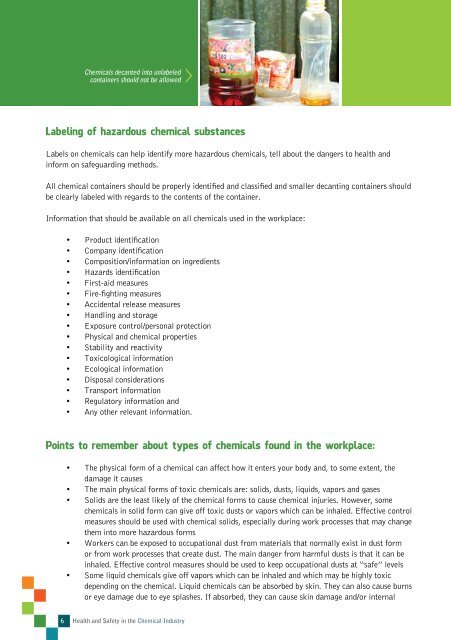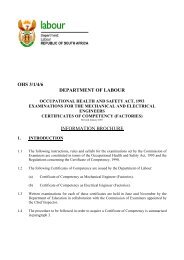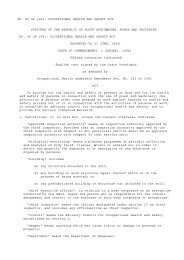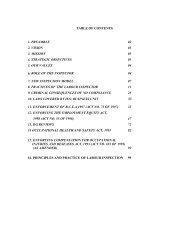Health and Safety in Chemical Industries.pdf - Department of Labour
Health and Safety in Chemical Industries.pdf - Department of Labour
Health and Safety in Chemical Industries.pdf - Department of Labour
You also want an ePaper? Increase the reach of your titles
YUMPU automatically turns print PDFs into web optimized ePapers that Google loves.
<strong>Chemical</strong>s decanted <strong>in</strong>to unlabeled<br />
conta<strong>in</strong>ers should not be allowed<br />
Label<strong>in</strong>g <strong>of</strong> hazardous chemical substances<br />
Labels on chemicals can help identify more hazardous chemicals, tell about the dangers to health <strong>and</strong><br />
<strong>in</strong>form on safeguard<strong>in</strong>g methods.<br />
All chemical conta<strong>in</strong>ers should be properly identified <strong>and</strong> classified <strong>and</strong> smaller decant<strong>in</strong>g conta<strong>in</strong>ers should<br />
be clearly labeled with regards to the contents <strong>of</strong> the conta<strong>in</strong>er.<br />
Information that should be available on all chemicals used <strong>in</strong> the workplace:<br />
• Product identification<br />
• Company identification<br />
• Composition/<strong>in</strong>formation on <strong>in</strong>gredients<br />
• Hazards identification<br />
• First-aid measures<br />
• Fire-fight<strong>in</strong>g measures<br />
• Accidental release measures<br />
• H<strong>and</strong>l<strong>in</strong>g <strong>and</strong> storage<br />
• Exposure control/personal protection<br />
• Physical <strong>and</strong> chemical properties<br />
• Stability <strong>and</strong> reactivity<br />
• Toxicological <strong>in</strong>formation<br />
• Ecological <strong>in</strong>formation<br />
• Disposal considerations<br />
• Transport <strong>in</strong>formation<br />
• Regulatory <strong>in</strong>formation <strong>and</strong><br />
• Any other relevant <strong>in</strong>formation.<br />
Po<strong>in</strong>ts to remember about types <strong>of</strong> chemicals found <strong>in</strong> the workplace:<br />
• The physical form <strong>of</strong> a chemical can affect how it enters your body <strong>and</strong>, to some extent, the<br />
damage it causes<br />
• The ma<strong>in</strong> physical forms <strong>of</strong> toxic chemicals are: solids, dusts, liquids, vapors <strong>and</strong> gases<br />
• Solids are the least likely <strong>of</strong> the chemical forms to cause chemical <strong>in</strong>juries. However, some<br />
chemicals <strong>in</strong> solid form can give <strong>of</strong>f toxic dusts or vapors which can be <strong>in</strong>haled. Effective control<br />
measures should be used with chemical solids, especially dur<strong>in</strong>g work processes that may change<br />
them <strong>in</strong>to more hazardous forms<br />
• Workers can be exposed to occupational dust from materials that normally exist <strong>in</strong> dust form<br />
or from work processes that create dust. The ma<strong>in</strong> danger from harmful dusts is that it can be<br />
<strong>in</strong>haled. Effective control measures should be used to keep occupational dusts at “safe” levels<br />
• Some liquid chemicals give <strong>of</strong>f vapors which can be <strong>in</strong>haled <strong>and</strong> which may be highly toxic<br />
depend<strong>in</strong>g on the chemical. Liquid chemicals can be absorbed by sk<strong>in</strong>. They can also cause burns<br />
or eye damage due to eye splashes. If absorbed, they can cause sk<strong>in</strong> damage <strong>and</strong>/or <strong>in</strong>ternal<br />
6 <strong>Health</strong> <strong>and</strong> <strong>Safety</strong> <strong>in</strong> the <strong>Chemical</strong> Industry

















